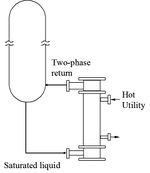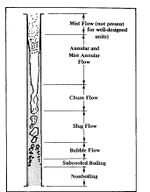Boiling Heat Transfer Coefficient

Boiling liquids have different heat transfer regimes. I: Heat transfer with natural convection II: Heat transfer with bubbling agitation III: Heat transfer with nucleate boiling with unstable film IV: Heat transfer with stable film boiling V: Radiant Heat Transfer
The heat transfer coefficient of a boiling liquid begins to decrease with the onset of film boiling. One method of improving the overall heat transfer coefficient is to use high-flux tubing, which utilizes a porous coating inside of tubes. It can improve boiling performance up to 10 times over a bare tube, and overall performance 2 to 5 times over a bare tube.
Kettle Reboilers

Kettle reboilers are often used as a steam generator. Pool boiling is used in kettle reboilers. In pool boiling, agitation occurs through bubbling and natural convection. The vapor-liquid separator is built-in and allows for blowdown. The weir helps to maintain the liquid level above the tube bundle. It also helps to prevent the entering bubble point liquid (distillation bottoms) from mixing with the residual reboiled liquid (exiting from the bottom). Kettle reboilers are more expensive than horizontal thermosiphons fabricated for a comparable duty.
Thermosiphon Reboilers

Thermosiphon reboilers use flow boiling. In flow boiling, agitation occurs through bubbling and forced convection at high velocities. They can be located at a height below the column sump. This allows the static head of the sump to force the column bottoms into the reboiler, which is designed for about 25 to 33% vaporization per pass. Thermosiphon reboilers can be vertical (tube-side) or horizontal (shell-side flow). Horizontal thermosiphon reboilers tend to be cheaper than vertical thermosiphons, but vertical thermosiphons are better at handling dirty fluids.

Flow is critical in a thermosiphon reboiler, and the different flow regimes will impact operation. The different flow regimes are caused by the increasing vapor/liquid ratio as the fluid passes through the thermosiphon.
Flow regimes in order of increasing vapor/liquid ratio: nonboiling < subcooled boiling < bubble flow < slug flow < churn flow < annular and mist flow < mist flow
Slug flow is unavoidable, but should be minimized. It causes noise and vibration in the thermosiphon. Annular and mist flow are also undesirable. Annular flow can be avoided by designing for less than 33% vaporization, and mist flow can be altogether avoided in well-designed reboilers.
Stab-in Reboilers

Stab-in reboilers are essentially the heat exchange tube bundle fitted inside a sump. In this case, the sump behaves in a similar capacity to a kettle reboiler, and mechanism of pooling is again pool boiling. It is important that there is enough space in the sump for good level control and to contain the entire tube bundle.
Leave a Reply